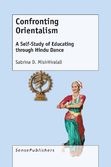dance
Select an item by clicking its checkbox
https://www.wabashcenter.wabash.edu/wp-content/uploads/2021/04/Perichoresis.mp3 John of Damascus, one of the most important theologians of Eastern Orthodox Christianity, writes the following about the relationship between the three Persons of the Trinity: [They] dwell and are established firmly in one another. For they are inseparable and cannot ...

Confronting Orientalism - A Self-Study of Educating through Hindu Dance
Date Reviewed: July 20, 2018
Sabrina D. MisirHiralall uses Kuchipudi dance rather than Western-based pedagogical and philosophical methodology to educate non-Hindus about her religious tradition. In her text, Confronting Orientalism: A Self-Study of Educating Through Hindu Dance, MisirHiralall describes her journey from learning this style of dance as a young woman to engaging learners in experiencing and thus better understanding the Hindu tradition through an epistemological approach that uses dance as means of dispelling perspectives based on a colonialist point of view and its subsequent influence on modern pedagogy. Her main purpose in doing so is to confront orientalism and address two of the primary lenses through which non-Hindus view what is called Hinduism. The first of these lenses sees adherents such as herself as exotic. The second lens imposes a Western understanding of religion on what she describes as a way of life (174).
In an extensive introductory chapter, MisirHiralall describes personal experiences as a child, and later as a young woman, that led her to consider methodology drawn from traditional ways of learning that utilize dance, storytelling, and music, rather than from texts. Why she has selected dance as the primary means of educating becomes clear; Through dance, the stories that shape the religious life of Hindus come alive. Dance invites her as the educator to present an authentic approach that teaches and informs. Teaching through dance allows her to interact more with the learner in both preparing for and experiencing the dance.
In subsequent chapters, MisirHiralall examines how effective teaching through dance can be and where it may not meet her expectations in overcoming orientalism. In her chapter “The Gazes,” MisirHiralall identifies different kinds of gaze: Imperial, Western male, and sacred. While her main objective is to encourage the sacred gaze, she describes how she continues to be subject to and the subject of the Western male gaze that perpetuates the exotic lens. The concept of gaze can be a complicated and multifaceted one. What she describes about gazes could also be applied to teachers and professors who encounter gazes of interest or disinterest. Gazes from learners are not limited to those she described. Instructors are subject to many types of gazes and are seen through many lenses.
Because this is a self-study, MisirHiralall includes references from her journal and supports her stance on teaching space, gaze, and epistemology with extensive research. Her text invites educators to consider how extensively Western methodology permeates the educational system and what challenges should be faced in overcoming “the illusionary boundaries of the West and the East” (176). This work suggests a way forward by which educators could engage personal assumptions and pedagogical
